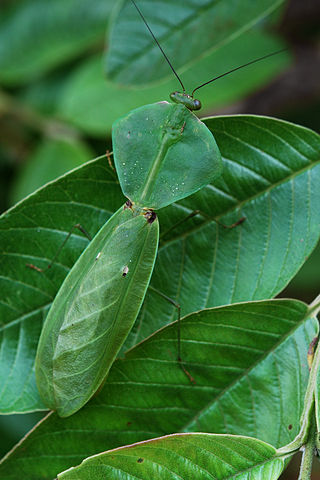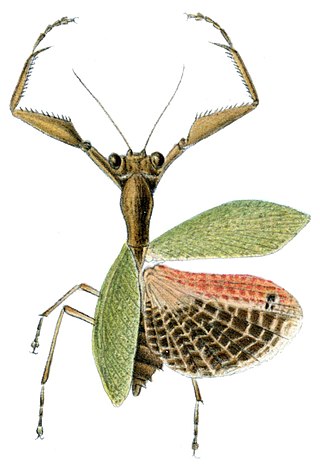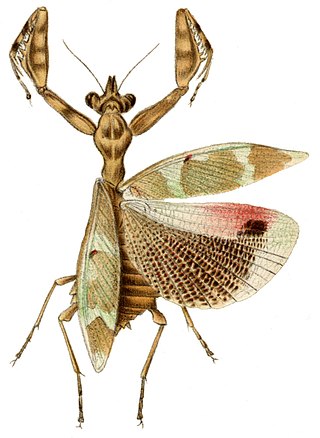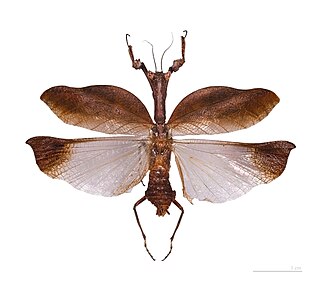
Choeradodis is a genus of praying mantises with common names such as shield mantis, hood mantis, and leaf mantis because of their extended, leaf-like thoraces. The distinguishing characteristic of Choreododis from which it takes its common names is a laterally expanded thorax. This adaptation for the purpose of camouflage, as well as a rounded wing case and a habit of staying relatively flattened, aid its leaf mimicry. Tiny liverworts, lichens and fungi have been found growing on the pronotum and wing case of many Choeradodis mantids; these appear to be opportunistic growths rather than an example of coevolution with the mantids to afford extra camouflage.

Acanthops falcataria, common name South American dead leaf mantis, is a species of mantis in the family Acanthopidae. It is not to be confused with Acanthops falcata, a different species in the same genus that is often referred to with the same common name.

Acanthops is a genus of mantises in the family Acanthopidae, containing 20 species that can be found in Central and South America.

Acontista is a genus of mantises in the family Acanthopidae.

Callibia is a genus of praying mantis in the family Acanthopidae. The genus contains only one species, Callibia diana.
Acanthops centralis is a species of praying mantis in the family Acanthopidae. It is found in Costa Rica, Panama, and Colombia.
Acontista multicolor is a small species of South American mantis in the family Acanthopidae.

Asiadodis yunnanensis is a species of praying mantis in the family Mantidae. It is found in China, Myanmar, and Thailand.

Decimiana is a genus of mantises in the family Acanthopidae.

Acanthopidae is a family of South American mantises consisting of 16 genera in the order Mantodea. The group was first formally split off as a separate family by the German entomologist Reinhard Ehrmann in 2002. In 2016, five genera were moved from Acanthopidae to the newly created family Acontistidae, but this has not been accepted in most recent classifications.
Miracanthops eseejja is a species of praying mantis in the family Acanthopidae that is native to Peru. It was first described in 2005 by Peruvian entomologist Julio Rivera.

Stenophylla is a genus of praying mantis in the subfamily Stenophyllinae, which is now placed in the family Acanthopidae. It the sole genus of the tribe Stenophyllini.

Acanthopini is a tribe of mantises in the family Acanthopidae. Ii is the only tribe in the subfamily Acanthopinae and contains eight genera and 37 species.

Metilia amazonica is a species of mantis of the family Acanthopidae that was historically Acanthops amazonica.
Metilia boliviana is a species of mantis of the family Acanthopidae.

Metilia brunnerii is a species of mantis of the family Acanthopidae.

Decimiana elliptica is a species of praying mantis in the genus Decimiana in the order Mantodea. The type specimens were collected from the Chapanda Diamantina Mountain Range in Bahia, northeastern Brazil, near a mountain known as Morro do Pai Inácio.

Acontistini is a tribe of neotropical mantises in the superfamily Acanthopoidea, and family Acanthopidae. There are 7 genera and more than 30 described species in Acontistini. In 2016, several genera were moved from Acanthopidae to a newly created family Acontistidae, but this has not been accepted in most recent classifications.










